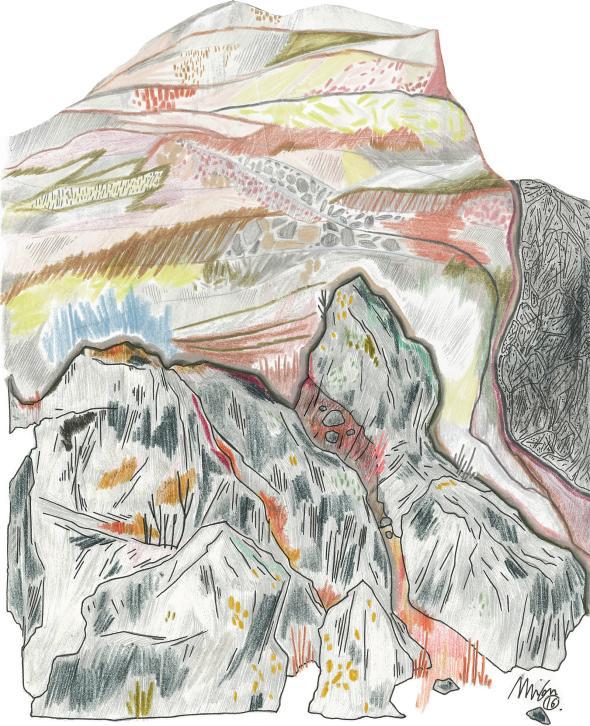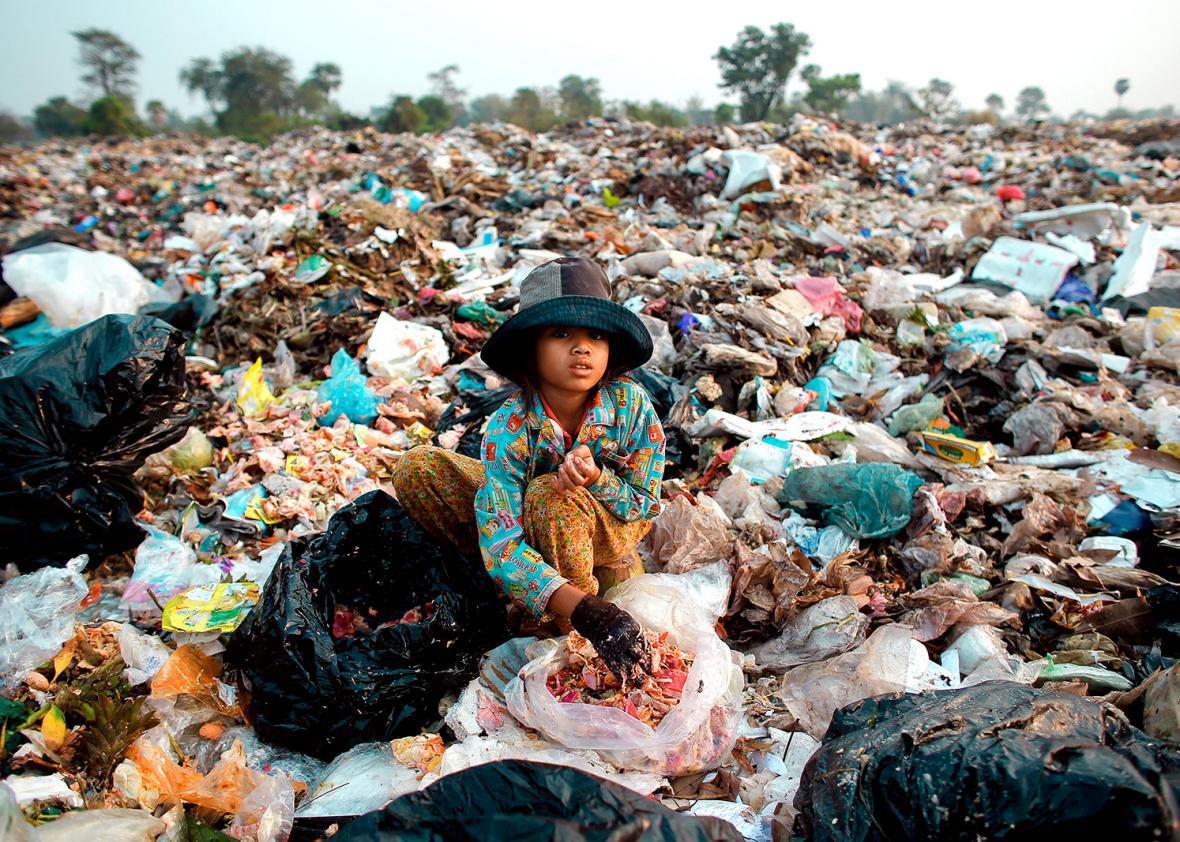You know that consumerism plays a massive role in climate change—all those fossil fuels we have to burn to make and ship our stuff, all those trees cut down to make way for expanding cities and businesses, all that livestock that sate our increasing appetites for burgers and steak. But the environmental impact that all of our material goods have on the planet goes far beyond the greenhouse gases emitted in the process of creating and transporting these things.
In fact, much of it has to do with what we leave behind. It’s a manmade phenomenon so massive that Earth scientists suggest it’s creating a distinct geological layer upon the Earth made up of technofossils. Most people associate geological layers with eras long gone: paleontologists digging up fossils of stegosauruses or ancient corals, the stunning layered lines of the Grand Canyon giving testimony to the billions of years of life on Earth. But we’re creating our own coating on the planet that will outlast us. Just as dinosaur bones and petrified wood persist, so too will markers of our time, and they increasingly include the nonorganic. Couches, ballpoint pens, garage doors, safety pins, zip drives, plastic water bottles, cars, buildings—almost anything that’s not recycled has the potential to fossilize—that is, partially or entirely preserved over time due to burial in the Earth or within layers of other fossils—think landfill. There are almost certainly numerous future technofossils in front of you right now.
More than just creating a geological mille feuille of our past, scientists warn that this phenomenon is also making a deep impact on our terrestrial future. And like the Anthropocene—another buzzword popular in the Earth sciences community used to mark a new geological epoch in which human influence became the dominant force on Earth—it represents a profound change.
According to a conservative geological estimate from a team of international researchers led by the University of Leicester, all this stuff weighs 30 trillion tons. That’s 110 pounds—the weight of a semi-truck’s tire—for every square meter of the earth’s surface. The group also calculated that the sheer diversity of the types of technofossils we as a species have made—it already exceeds the number of biotic species living on Earth now, and may even “exceed the total biological diversity through Earth’s history.”
The scale of our stuff is so gargantuan that it’s also creating an entire new sphere alongside the other major systems of our planet. We’ve long had the hydrosphere (water), atmosphere (air), lithosphere (earth), biosphere (organic life, like plants and animals). Now we have the technosphere (human constructions). Unlike the natural spheres that developed self-regulating systems and balanced interactions over millions of years, the technosphere’s geological newness throws off the quite robust balance of our natural systems—that’s how powerful it is.
Those who study it worry—among many other things—that the technosphere doesn’t function as a mostly closed system as other spheres do. A simple example is the hydrologic cycle: Water vapor evaporates into clouds, which rain down on landscapes, flow into rivers, and back out into the sea. This cycle took eons to develop into the mostly symmetric system we enjoy today. But the technosphere is moving at rates of change measured in decades, not eons, meaning that the complex checks-and-balances evolutionary process hasn’t had time to self-regulate. (Earth’s early geologic history is full of asymmetric spheres collapsing into chaos as during the Archean Eon; so many volcanoes erupted all at once it sent Earth into a superheated greenhouse state.)
Worst of all, as our growing landfills show, it’s remarkably poor at recycling its own materials. In the biosphere, there’s little waste—the redwood tree falls after hundreds of years of growth, and becomes a home for small mammals, plants and mushrooms, which all break it down into the soil below; baby redwoods literally grow out of the body of the old tree, a cycle in which life is continuously supported, and no trash is created. Long term, lack of nutrients and energy cycling is a death knell for any natural system, and the technosphere uses vast amounts of finite resources like fossil fuels, precious metals, topsoil, fresh water, and other products of the biosphere, lithosphere, and hydrosphere. It sucks up so many resources that Jan Zalasiewicz, one of the University of Leicester geologists leading a multiyear study of the technosphere, told me that he views it as a rapidly evolving parasite upon our entire planet.
That’s not hyperbole: To create our world of stuff, the technosphere is consuming resources the rest of the planet needs to maintain its systems. And just like a tapeworm or malaria protozoans, it doesn’t care if it disables or kills its host. To be clear, the waste itself isn’t the parasite, it’s simply the evidence of it—those technofossils are the carcasses left behind by a parasitic system. A healthy system leaves no waste. If the technosphere continues unchecked, it will ultimately do what all parasites do.
Alas, the cure won’t be as simple as getting rid of fleas. The technospehre itself is here to stay. Human success on Earth is tied to the world we have built—our cities, our agriculture, our power supplies, our clothing, our transportation, and our technologies. In short, we’ve converted part of the Earth into a machine to support humanity. And, as Zalasiewicz told me, “We are part of the technosphere, a component, and we have to keep it going because it keeps us going.”
But additional technofossils —and the wasteful system they represent—are not necessarily inevitable. We can make the technosphere smarter by nudging it toward a more mutualistic relationship, rather than a parasitic one.

Like the natural spheres developed over millions of years on the earth, the technosphere can and will evolve over time. “I look at the technosphere’s systems as the next biology,” says Peter Haff, professor emeritus of geology and civil and environmental engineering at Duke University, who first coined the term in 2013. Haff is philosophical and thinks in geologic time when considering long-term implications of the technosphere: “It’s just the newest thing that Earth is doing. We just happen to be living at this time when there is a change happening.” This “emergent structure,” like the other spheres, grows and changes to improve its own functionality, not ours—Haff suggests that we should influence the technosphere to behave more the like the other, beneficial spheres while we still can. “For [the technosphere’s] own longer term survival, and for ours, recycling is essential,” he says.
Especially at these early stages, we can likely mitigate some of its most parasitic effects by reshaping it to better work with its finely tuned, self-regulating spherical peers. To start, we need to push the technosphere to “function in tandem with a biosphere that is stable, rather than one that is rapidly degrading,” says Zalasiewicz. That means it needs to be (much) better at reusing resources, by mimicking how the other spheres work—all of which recycle continuously, in a circular process.
The sharing economy actually represents a good model for the technosphere—after all, it reduces resource use (and therefore waste) by getting consumers to rethink their individual ownership of stuff. Likewise, concepts like the circular economy (in which waste is eliminated completely by moving away from the linear model of make-use-discard into one where we grow or produce new things from recycled components) can push the technosphere back into a relatively healthy circle of resource use and reuse—similar to how the other spheres have evolved.
The critical thing to understand about the technosphere is that, like the other spheres, it doesn’t care whether humans survive. It exists outside of us, even if it includes us. There’s nobody in charge of the technosphere, nobody knows exactly how it works as a whole, and nobody designed it.
Ultimately, in a healthy technosphere, no waste would be produced, and no technofossils (or at least, very few on par with what’s left behind by the other spheres) would be left behind. It might make future geologists’ work less interesting, but at least there will be scientists puzzling over their ancestors in the future.
This article is part of Future Tense, a collaboration among Arizona State University, New America, and Slate. Future Tense explores the ways emerging technologies affect society, policy, and culture. To read more, follow us on Twitter and sign up for our weekly newsletter.
